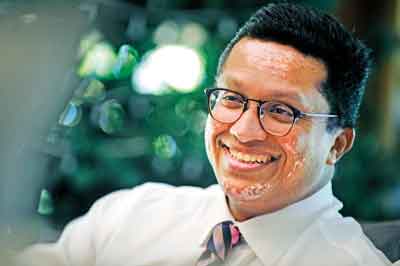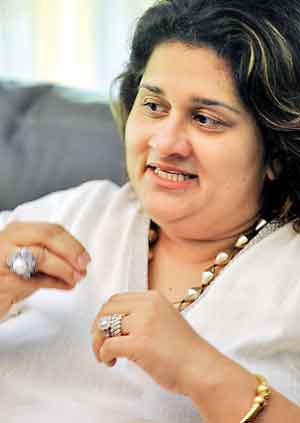‘Unmasked’ and facing the world with humility

Dilhan Fernando: Only a few patches now and (inset left) as he was before. Pic by Amila Gamage
Plunged to the deepest depths of despair, now they have been raised to unimaginable heights.
“A terrible curse on my life has turned out to be the greatest blessing,” is the opening line with which 49-year-old Dilhan Fernando guides us through a life challenged to the very core by vitiligo or leucoderma.
For Sri Lankans it is plain “kabara” as derogatorily called by all and sundry and is accompanied by looks of distaste and aversion.
What helped Dilhan and his dearest and nearest, wife Serena (47), and children, son Amrit (16), daughter Amaya (12) and son Devin (10) to face it up front and believe that a cure is imminent is the golden thread that runs through the interview as we chat in their elegant home overlooking a beautiful garden off Buthgamuwa Road in the heart of Rajagiriya, sipping cinnamon tea and tucking into delicious cake.
The make-up behind which the vitiligo was well and truly hidden for many long years is long gone and as we look closely back and forth at Dilhan’s face and a large photograph of him taken a while ago lying on the coffee table, the change is stunning………where earlier the lighter patches dominated his whole face, now much of it has receded and what is left is restricted to the forehead and the chin.
“A miracle is something that God does for you, healing is what God does in you,” says Dilhan quoting Pastor Colton Wickramaratne, adding fervently while Serena nods vigorously: “My story demonstrates that what God has done in me is ‘much greater’ than what God has done for me.”
Dilhan needs no introduction in the local or international arena. Most recently appointed the Chief Executive Officer of the industry giant, Dilmah Ceylon Tea Company Plc, by dad and business leader Merrill J. Fernando, Dilhan has been the ‘face’ of Dilmah for a long while, even before as a Director of the firm.
 We glimpse the journey of Dilhan and soul-mate Serena long before vitiligo stared them in the face. It was to a life of comfort and affluence that Dilhan was certainly born, Public School followed by the London School of Economics in England and then back home to help run, along with brother Malik, a thriving and expanding business built up by their father to give Ceylon tea its rightful place in the world.
We glimpse the journey of Dilhan and soul-mate Serena long before vitiligo stared them in the face. It was to a life of comfort and affluence that Dilhan was certainly born, Public School followed by the London School of Economics in England and then back home to help run, along with brother Malik, a thriving and expanding business built up by their father to give Ceylon tea its rightful place in the world.
Having fallen in love after seeing each other at a party when Serena was just 19, Dilhan and she were married in 1996, forming an inseparable “Dilly-Seri” bond evident even 21 years later, as they recall the saga of their lives, prompting each other and jogging each other’s memory.
The world was at the feet of the young couple, everything and anything that could be wished for………. a wonderful marriage, good looks, education, wealth and more.
And then one fine day, about one year into their marriage, lighter patches appeared on Dilhan’s face.
Life would never be the same again. The “Why me?” in those early years, the search for answers, the tears and the agony, the trials and the tribulations, the cruelty not only of strangers but also friends and relatives, they have lived through it all, seeing the light in humility.
They had no clue why. They went to the top doctors and to anyone else who gave even an iota of hope. The theories were many – you must have done something bad, you must have been bitten by a rat, it must be dandruff falling on your face causing the pigmentation to change. Whatever they did or whatever medications including the application of various creams helped not at all.
The verdict was “blunt” and came when a friend took them to India in 1998 to meet Prof. Lalit Bhutani of the All-India Institute of Medical Sciences (AIIMS), New Delhi.
Vitiligo, they were told, “devastating” them. The additional information was comforting but did not alleviate their anxiety. It is not a danger to life, it is not contagious but a cosmetic disease linked to the pigmentation of the skin. (See box please)
The long and arduous treatment began then, steroids to kick-start production in the pigment-forming cells, melanocytes, but to no avail.
Gently, Serena reminds Dilhan how earlier they made their way four times a week to the acupuncture clinic of Dr. Anton Jayasuriya in Wellawatte and she would sit out the four-five hours when he was stuck with pins all over his body or had light treatment.
It only got worse, says Serena, also shuddering at the thought of the rigorous beheth wattoruwa set by a Veda Hamine under the ayurvedic system. Dilhan’s diet had to be free of all meats and also acidic stuff like pineapple, while Serena would have on her lap a tray with pastes made of bundles of leaves given by the Veda Hamine. Different pastes had to be applied on different days with Dilhan having to stay in bright sunlight after that. “There were oils (thel) and guli that had to be taken scrupulously,” says Serena recalling how Dilhan’s face would rupture out as diya patta (blisters), not tiny but huge which would then begin oozing. Those were the times he was in agony. That ended when they found that metals such as mercury and gold were part of the so-called treatment, which were impacting adversely on Dilhan’s liver.
The ‘camouflage’ came next with another friend taking Dilhan to a salon but he looked like an avatar. He kept trying different camouflages, even actor’s make-up where the solvent was alcohol based and extremely painful, like “pouring spirits onto a wound” which he used for a while, gritting his teeth.
This was the point when he and Serena questioned: “What is this? Why all this suffering?”
Dilhan groups his life after vitiligo into three – the first phase when they remained completely isolated, not venturing out anywhere, becoming social outcasts. “My self-confidence was shattered,” says Dilhan.
The second phase began with an encounter with Nissanka Wimalasuriya who was introduced by a friend with the words, “He’ll help you”. The recollections of that meeting are still vivid, for unassuming Mr. Wimalasuriya had said a prayer in the very area that we are seated and pointed towards a tree in the garden.
A little digging unearthed a charm. Mr. Wimalasuriya’s advice to them was to follow two courses of action – look at it in the true spirit of God and don’t seek the perpetrator for revenge but forgive him, says Serena.
Around this time Dilhan had found make-up which could be used to cover what he felt were shameful scars on his face. The substance came in jars and tubes of Kryolan from Charles Fox, well-known manufacturers of make-up for artists in Covent Gardens.
For Dilhan and Serena these depths of despair were part of God’s plan to teach them humility and re-build and mould their characters, while inculcating in them the need to help and serve others. Gradually, they found it in their hearts to forgive the person who had concocted a charm against Dilhan, both say in one voice.
“We learnt to be thankful that we woke up, that we had fresh air to breathe, that there was light around us and that there were birds singing in the trees,” says Dilhan.
The third and crucial phase began on July 24, 2015, say Dilhan and Serena without hesitation over the date. They were visiting friends in America, when Dilhan looked at a picture of Christ in his room and said: “Jesus if You are real, heal me”.

Serena: Dilhan’s soul-mate
As they prayed, what another man of faith said “chilled” Dilhan to the bone……“God created you and sees you as beautiful” and next morning Dilhan was moved to do away with his make-up.
But it was not easy and he just could not leave the bedroom, until his daughter Amaya walked in and gave him moral support.
Dilhan and Serena talk of the immense support from their three children, their close relatives and staff of Dilmah. Son Amrit had photographed Dilhan soon after the make-up was off, addressing large gatherings during six high teas Dilmah hosted in Australia and used it as his wallpaper on his mobile with “Why fit in, when born to stand out”.
All this is recent history and the family believes that choicest blessings are being showered on them. Recently in Singapore when UNDP hosted the ‘Responsible Business Forum’ in November, CNBC (Consumer News and Business Channel) chose just three for TV interviews – two Ministers from Singapore and Thailand respectively and Dilhan from Sri Lanka. Dilhan, however, humbly attributes this to serving God’s purpose rather than dubbing it a personal achievement.
For Dilhan the message is simple: “We often define our expectations from God in our own terms, whether it is healing from vitiligo or any other issue. God does not subscribe to our terms. I initially thought that when I was not receiving my healing, that He did not hear my prayers. I learned later that He hears every prayer, but His response was much greater than I could imagine.
“The cosmetic healing from the issue I faced was only a part of it and in God’s terms, He wanted so much more for me and therefore gave me strength of character, a fundamentally different perspective – elements of wisdom that I could never have acquired had He simply granted the miracle I desperately sought. When people question why they have to go through situations, they need to understand that it is those situations that build strength and while God may not give a ready response in the form of a miracle, He will use those situations to mould, refine, strengthen and ultimately bless.”
Whether it is a child with Down’s Syndrome, a youth with autism or a man or woman from a slum, the interaction not only with Dilhan but also his whole family says it all – they may be from the highest echelons of society but the humility, the caring and the sharing are obvious, fostered by absolute faith.
| Views of a senior Dermatologist | |
| Vitiligo is due to a loss of pigment (the natural colouring matter of animal or plant tissue) in the skin. It occurs when cells that produce melanin which gives the skin its colour stop functioning or die. Although the cause is unknown contributory factors could be an autoimmune disorder where a person’s own immune system mistakenly attacks his/her body; family history, a virus; coming into contact with harmful chemicals; or stress. It is usually a lifelong condition. “There are different kinds of vitiligo, there are different stages of vitiligo and there are different types of treatment, some of which could bring about a cure in some patients,” a senior Consultant Dermatologist told the Sunday Times. According to him the treatment includes applications, oral medications, light treatment, skin-grafting and stem-cell therapy and some people who seek treatment early benefit by them. Usually children who have vitiligo, depending on the type and stage of the condition and the treatment, can get completely cured, he said, adding that for those who do not get cured there are effective camouflage creams. The Dermatologist said that if vitiligo has got cured for some reason or other, there should be objective evidence of healing. These could come in the form of a series of photographs before and after. Pointing out that science is driven by objectivity, he adds that the human body has an immense healing capacity. |


